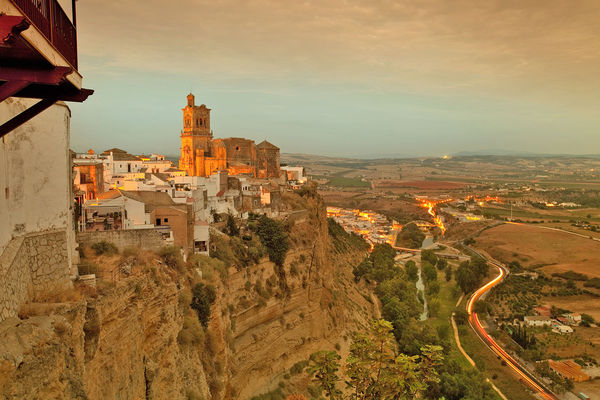Arcos de la Frontera: Nuns’ Cupcakes and Donkeys in the Bell Tower
By Rick Steves
I'm in the little hill town of Arcos de la Frontera, just south of Sevilla. Today, my goal is to connect with the culture of small-town Spain.
Arcos smothers its hilltop, tumbling down all sides like the train of a wedding dress. The labyrinthine old center is a photographer's feast. I can feel the breeze funnel through the narrow streets as drivers pull in car mirrors to squeeze through.
Residents brag that they only see the backs of the birds as they fly. To see what they mean, I climb to the viewpoint at the main square, high in the old town. Bellying up to the railing — the town's suicide jumping-off point — I look down and ponder the fancy cliffside hotel's erosion concerns, orderly orange groves, flower-filled greenhouses, fine views toward Morocco…and the backs of the birds as they fly.
Exploring the town, I discover that a short walk from Arcos' church of Santa María to the church of San Pedro (St. Peter) is littered with subtle but fun glimpses into the town's past.
The church of Santa María faces the main square. After Arcos was retaken from the Moors in the 13th century, the church was built — atop a mosque. In the pavement is a 15th-century magic circle: 12 red and 12 white stones — the white ones represent various constellations. When a child came to the church to be baptized, the parents would stop here first for a good Christian exorcism. The exorcist would stand inside the protective circle and cleanse the baby of any evil spirits. This was also a holy place back in Muslim times. While Christian residents no longer use it, Islamic Sufis still come here on pilgrimage every November.
In 1699, an earthquake cracked the church's foundation. Today, arches reach over the narrow lane — added to prop the church against neighboring buildings. Thanks to these braces, the church survived the bigger earthquake of 1755. All over town, similar arches support earthquake-damaged structures.
Today, the town rumbles only when the bulls run. Señor González Oca's little barbershop is plastered with posters of bulls running Pamplona-style through the streets of Arcos during Holy Week. Locals still remember an American from the nearby Navy base at Rota, who was killed by a bull in 1994.
Walking on toward St. Peter's, Arcos' second church, I pass Roman columns stuck onto street corners — protection from reckless donkey carts. St. Peter's was, until recently, home to a resident bellman who lived in the spire. He was a basket maker and a colorful character — famous for bringing his donkey up into the tower. The donkey grew too big to get back out. Finally, the bellman had no choice but to kill the donkey — and eat it.
The small square in front of the church — about the only flat piece of pavement around — serves as the old-town soccer field for neighborhood kids.
At a nearby convent, the windows are striped with heavy bars and spikes. Popping into the dimly lit foyer, I push the buzzer and the creaky lazy Susan spins, revealing a bag of freshly baked cookies for sale. When I spin back the cookies with a "no, gracias," she surprises me with a few words of English — countering, in a Monty Python-esque voice, "We have cupcakes as well." I buy a bag of cupcakes to support the mission work of the convent. I glimpse — through the not-quite one-way mirror — the not-meant-to-be-seen sister in her flowing robe and habit momentarily appear and disappear.
Saving my appetite for dinner, I dole out my cupcakes to children as I wander on. My town walk culminates at another convent — which now houses the best restaurant in town, Restaurante El Convento. María Moreno Moreno, the proud owner, explains the menu. (Spanish children take the name of both parents — who in María's case must have been distant cousins.) As church bells clang, she pours me a glass of vino tinto con mucho cuerpo (full-bodied red wine) from the Rioja region.
As I sip the wine, María asks how my visit is going. I tell her that the entire town is a mucho cuerpo experience…creating memories that will be a treasured souvenir.
This article was adapted from Rick's new book, For the Love of Europe.

